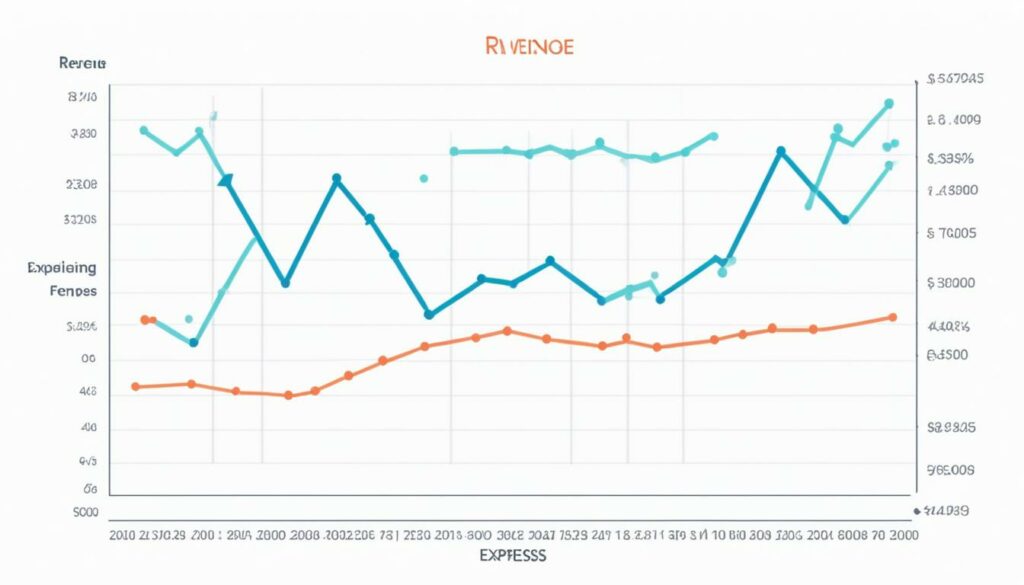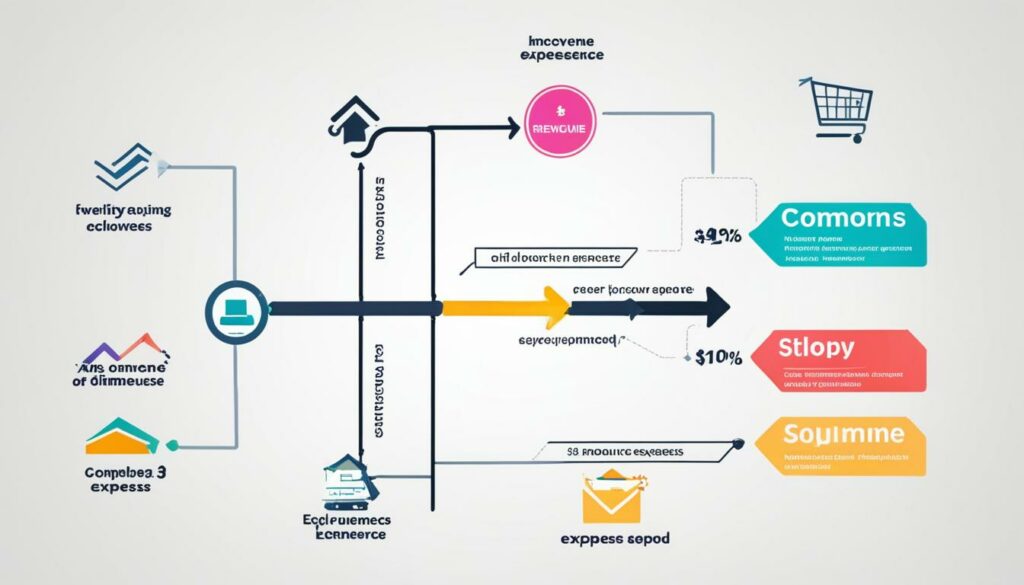An income statement, also known as a profit and loss statement or P&L statement, is a key financial statement in ecommerce. It provides a comprehensive view of a business’s financial performance by showing the revenue generated and expenses incurred over a specific period of time. The income statement is essential in tracking the profitability of an ecommerce business and plays a crucial role in making strategic financial decisions.
It is often generated monthly, quarterly, or annually and provides insights into the company’s revenue, cost of goods sold, gross profit, operating expenses, operating income, net income, and other financial metrics. Understanding the essentials of an income statement is fundamental for ecommerce entrepreneurs to evaluate the financial health of their businesses and implement strategies to improve profitability.
Key Takeaways:
- An income statement, also known as a profit and loss statement or P&L statement, is a crucial financial statement in ecommerce.
- It provides a comprehensive view of a business’s financial performance by showing revenue and expenses over a specific period of time.
- The income statement helps track profitability and aids in making strategic financial decisions.
- Understanding the essentials of an income statement is vital for evaluating the financial health of an ecommerce business.
- Improving profitability requires careful analysis and utilization of the income statement.
The Importance of an Income Statement in Ecommerce
An income statement is a vital financial statement for ecommerce businesses. It provides a comprehensive view of the business’s financial performance, helping entrepreneurs understand their revenue, expenses, and overall profitability. By analyzing the income statement, ecommerce businesses can make informed decisions to improve their financial performance and drive success.
“The income statement is the compass that guides ecommerce businesses towards financial success.”
Tracking Revenue and Assessing Cost of Goods Sold
The income statement enables ecommerce entrepreneurs to track the revenue generated from sales. This crucial insight allows businesses to evaluate the effectiveness of their sales strategies, pricing models, and marketing campaigns. Additionally, the income statement helps businesses assess the cost of goods sold (COGS), providing valuable information on the profitability of their products and services.
Gaining Visibility into Gross Profit and Operating Expenses
With the help of the income statement, ecommerce businesses can calculate their gross profit by subtracting COGS from revenue. This figure represents the amount of money left over after covering direct production costs, indicating the effectiveness of the business’s production processes and pricing strategies. Furthermore, the income statement allows businesses to evaluate their operating expenses, including marketing, payroll, and general administration costs. By closely monitoring these expenses, ecommerce entrepreneurs can identify areas for cost optimization and efficiency improvements.
Making Informed Decisions to Improve Profitability
The income statement serves as a valuable tool for making data-driven decisions to improve profitability in ecommerce. By analyzing the revenue and expense data, entrepreneurs can identify trends, pinpoint areas of success, and uncover potential bottlenecks. This information empowers businesses to make strategic decisions, such as adjusting pricing, optimizing marketing channels, and streamlining operations to enhance overall financial performance.
“The income statement provides ecommerce entrepreneurs with the insights needed to navigate the ever-evolving landscape of online business and drive sustainable profitability.”
Attracting Investors and Lenders
The income statement plays a crucial role in attracting potential investors and lenders to ecommerce businesses. These financial stakeholders assess the income statement to gauge the financial health and viability of the business. A well-structured and positive income statement can instill confidence in investors and lenders, increasing the chances of securing funding for growth and expansion.
Calculations and Components of an Income Statement in Ecommerce
In ecommerce, understanding the calculations and components of an income statement is crucial for evaluating financial performance. The income statement provides valuable insights into the revenue, expenses, and profitability of an ecommerce business. Let’s explore the key calculations and components of an income statement:
1. Revenue:
Revenue represents the income generated from sales in an ecommerce business. It includes the total amount of money earned from selling products or services to customers.
2. Cost of Goods Sold (COGS):
COGS refers to the direct costs associated with producing or acquiring the goods sold. This includes the cost of materials, manufacturing, packaging, and shipping.
3. Gross Profit:
Gross profit is calculated by subtracting the COGS from the revenue. It represents the amount of money left after deducting the direct costs of producing or acquiring the goods sold.
4. Operating Expenses:
Operating expenses encompass various costs incurred in the day-to-day operations of the business. This includes marketing expenses, payroll, rent, utilities, and general administrative costs.
5. Operating Income:
Operating income is determined by subtracting the operating expenses from the gross profit. It indicates the profitability of the core operations of the business.
6. Other Income and Expenses:
Other income and expenses include any additional sources of income or expenses that are not directly related to the core operations of the business. This can include interest income, non-operating revenue, one-time expenses, and other financial activities.
7. Net Income:
Net income is the final calculation in the income statement. It represents the profit or loss after subtracting taxes and other expenses from the operating income. Net income is a key indicator of the overall financial performance of an ecommerce business.
By understanding these calculations and components, ecommerce entrepreneurs can accurately interpret the information presented in an income statement. Analyzing the income statement allows businesses to evaluate financial performance, identify areas for improvement, and make informed decisions to optimize profitability.
| Component | Definition |
|---|---|
| Revenue | The income generated from sales in the ecommerce business. |
| Cost of Goods Sold (COGS) | The direct costs associated with producing or acquiring the goods sold. |
| Gross Profit | The amount of money left after deducting COGS from revenue. |
| Operating Expenses | The costs incurred in the day-to-day operations of the business. |
| Operating Income | The profitability of the core operations of the business. |
| Other Income and Expenses | Additional sources of income or expenses not directly related to the core operations. |
| Net Income | The profit or loss after subtracting taxes and other expenses from the operating income. |
Understanding and analyzing the calculations and components of an income statement is essential for ecommerce businesses to evaluate their financial performance and make strategic decisions to drive profitability.
Strategies to Improve the Income Statement in Ecommerce
Enhancing the income statement is a crucial objective for ecommerce businesses seeking to improve their financial performance. Implementing effective strategies can lead to significant improvements in the income statement, resulting in enhanced profitability and sustainable growth. Here are several strategies that ecommerce businesses can consider:
1. Increase Revenue
To improve the income statement, focus on increasing revenue through targeted marketing campaigns, expanding your customer base, and optimizing pricing strategies. By effectively promoting your products or services, reaching a wider audience, and offering competitive pricing, you can boost sales and revenue.
2. Reduce Costs of Goods Sold
Reducing the costs of goods sold (COGS) can have a significant impact on the income statement. Negotiating better deals with suppliers, improving supply chain management, and implementing cost-effective production methods can help lower COGS, resulting in higher gross profits.
3. Control and Minimize Operating Expenses
Operating expenses, such as marketing costs, payroll, and general administration, can eat into profitability. Implement strategies to control and minimize these expenses, such as streamlining operations, exploring automation opportunities, and renegotiating contracts with service providers.
4. Explore Diversification and Expansion
Expand your revenue streams by exploring opportunities for diversification and expansion. Consider adding complementary products or services to attract new customers and increase sales. Additionally, expanding into new markets or geographic regions can open up new opportunities for growth.
5. Invest in Technology and Automation
Investing in technology and automation can improve efficiency, reduce costs, and enhance overall financial performance. Implementing advanced ecommerce platforms, utilizing data analytics tools, and automating repetitive tasks can lead to increased productivity and profitability.
6. Monitor and Analyze Key Performance Indicators (KPIs)
Closely monitor and analyze key performance indicators (KPIs) related to revenue, expenses, and profitability. Regularly review and evaluate your income statement alongside other financial metrics to identify trends and areas for improvement. This data-driven approach can guide decision-making and help optimize financial performance.
By implementing these strategies and closely monitoring the income statement, ecommerce entrepreneurs can make informed decisions to enhance their financial performance, improve profitability, and ensure the long-term success of their businesses.
Understanding Customer Behavior through the Income Statement in Ecommerce
The income statement in ecommerce not only provides valuable insights into the financial performance of a business but also offers valuable information about customer behavior and preferences. By closely analyzing the revenue data and sales trends presented in the income statement, ecommerce businesses can gain a deeper understanding of customer buying patterns, identify popular products and categories, and make data-driven decisions to improve their overall profitability.
Through the income statement, ecommerce entrepreneurs can track the revenue generated from different products and categories, allowing them to identify the most popular offerings among their customers. This information helps in making strategic decisions regarding inventory management and product selection. By ensuring that popular items are always in stock, businesses can meet customer demands and prevent missed sales opportunities.
Pricing strategies can also be derived from the income statement analysis. By examining the revenue generated from different price points, ecommerce businesses can identify optimal price ranges for their products that maximize profitability while remaining competitive in the market.
Furthermore, the income statement enables ecommerce businesses to track customer acquisition costs, allowing them to determine the most effective marketing channels for engaging and attracting new customers. By identifying the channels that yield the highest return on investment, businesses can allocate their marketing budgets more efficiently, thereby optimizing their customer acquisition strategies.
Key Insights:
“The income statement not only reveals the financial performance of an ecommerce business but also serves as a treasure trove of valuable information about customer behavior and preferences.”
- The income statement helps identify popular products and categories among customers.
- It enables data-driven decisions regarding inventory management and product selection.
- Pricing strategies can be derived by analyzing revenue data.
- Customer acquisition costs can be tracked to identify effective marketing channels.

By understanding customer behavior through the income statement, ecommerce businesses can tailor their strategies to meet customer needs, drive sales, and ultimately improve profitability. The income statement acts as a window into not only the financial health of the business but also the preferences and behavior of its customer base. This valuable information can inform marketing campaigns, inventory management, pricing strategies, and overall business decision-making.
The Relationship between the Income Statement and Other Financial Metrics in Ecommerce
The income statement in ecommerce is not only a standalone financial statement but also plays a critical role in providing insights into the relationship between various financial metrics. By analyzing the income statement alongside other key metrics, ecommerce businesses can gain a comprehensive understanding of their financial performance and make informed decisions to optimize profitability and overall success.
Gross Margin
Gross margin is a vital metric that measures the profitability of a business’s core operations. It represents the percentage of revenue that remains after deducting the cost of goods sold (COGS). The income statement provides the necessary data to calculate gross margin, enabling ecommerce businesses to evaluate their pricing strategies, negotiate better deals with suppliers, and optimize inventory management.
Net Profit Margin
Net profit margin is another important metric that reflects the overall profitability of an ecommerce business. It represents the percentage of revenue that remains as net income after deducting all expenses, including COGS, operating expenses, interest expenses, and taxes. The income statement provides the necessary information to calculate net profit margin, allowing businesses to assess the efficiency of their operations and identify areas for improvement.
Return on Investment (ROI)
Return on investment is a key financial metric that measures the profitability of an investment. By comparing the income generated from an investment to the cost of that investment, ROI provides insights into the financial performance and effectiveness of various initiatives. The income statement, with its revenue and expense data, allows ecommerce businesses to calculate ROI and assess the profitability of their marketing campaigns, new product launches, and other strategic investments.
Customer Acquisition Cost (CAC)
Customer acquisition cost refers to the amount of money an ecommerce business spends on acquiring new customers. By analyzing the income statement, businesses can identify the expenses associated with customer acquisition, such as marketing costs, sales commissions, and advertising expenses. Understanding the relationship between the income statement and CAC enables businesses to evaluate the effectiveness of their customer acquisition strategies and optimize their marketing budgets.
Customer Lifetime Value (CLV)
Customer lifetime value represents the total revenue that a customer is expected to generate over their entire relationship with an ecommerce business. By leveraging the income statement data, businesses can estimate CLV by analyzing customer purchase history, average transaction values, and repeat purchase rates. Understanding the relationship between the income statement and CLV enables businesses to make data-driven decisions regarding customer retention, loyalty programs, and personalized marketing strategies.
By analyzing the income statement in conjunction with these financial metrics and others that are relevant to a specific ecommerce business, entrepreneurs can gain valuable insights into their financial health, profitability, and efficiency. This comprehensive understanding empowers businesses to make informed decisions, develop effective strategies, and drive long-term success.
| Financial Metric | Definition | Calculation |
|---|---|---|
| Gross Margin | Percentage of revenue that remains after deducting COGS | (Revenue – COGS) / Revenue |
| Net Profit Margin | Percentage of revenue that remains as net income after deducting all expenses | (Net Income / Revenue) x 100 |
| Return on Investment (ROI) | Measure of the profitability of an investment | (Net Income from Investment / Cost of Investment) x 100 |
| Customer Acquisition Cost (CAC) | Cost of acquiring a new customer | Total Expenses on Customer Acquisition / Number of New Customers |
| Customer Lifetime Value (CLV) | Total revenue expected to be generated by a customer over their entire relationship with the business | Average Transaction Value x Purchase Frequency x Customer Lifespan |

Challenges and Considerations in Interpreting the Income Statement for Ecommerce Businesses
The income statement is a crucial financial statement for ecommerce businesses, providing valuable insights into their financial performance. However, interpreting the income statement can present several challenges and considerations that ecommerce entrepreneurs must be aware of.
One of the main challenges is accurately categorizing expenses and revenue streams. Ecommerce businesses often have complex operations, including inventory management, shipping costs, returns, and discounts. These complexities can make it difficult to accurately categorize and represent financial performance in the income statement.
Moreover, seasonality and fluctuations in sales volumes can impact the accuracy of the income statement. Ecommerce businesses may experience peak sales periods during certain seasons or holidays, which can skew the financial data. It is important for businesses to consider the timing and seasonality of their financial data when interpreting the income statement.
To overcome these challenges, ecommerce entrepreneurs need to carefully analyze the income statement, taking into consideration the unique aspects of their business model and industry. By making informed interpretations and addressing these challenges, ecommerce businesses can effectively utilize the income statement to drive financial success.
FAQ
What is an Income Statement in Ecommerce?
An income statement, also known as a profit and loss statement or P&L statement, is a key financial statement in ecommerce. It provides a comprehensive view of a business’s financial performance by showing the revenue generated and expenses incurred over a specific period of time.
Why is an Income Statement important in Ecommerce?
The income statement is essential in tracking the profitability of an ecommerce business and plays a crucial role in making strategic financial decisions. It provides insights into the company’s revenue, cost of goods sold, gross profit, operating expenses, operating income, net income, and other financial metrics.
What are the calculations and components of an Income Statement in Ecommerce?
The income statement consists of various components such as revenue, cost of goods sold (COGS), gross profit, operating expenses, operating income, other income and expenses, and net income. Understanding these calculations and components is vital for accurately interpreting and utilizing the information presented in an income statement.
What strategies can be implemented to improve the Income Statement in Ecommerce?
Ecommerce businesses can focus on increasing revenue, reducing costs of goods sold, controlling operating expenses, and exploring opportunities for diversification and expansion to enhance the income statement and improve financial performance.
How can the Income Statement help in understanding customer behavior in Ecommerce?
By analyzing revenue data and sales trends, ecommerce businesses can identify popular products, understand customer buying patterns, and tailor their strategies to meet customer needs and improve profitability.
What is the relationship between the Income Statement and other financial metrics in Ecommerce?
The income statement provides valuable information that can be used in conjunction with metrics like gross margin, net profit margin, return on investment (ROI), customer acquisition cost (CAC), and customer lifetime value (CLV) to evaluate the financial health and profitability of an ecommerce business.
What are the challenges and considerations in interpreting the Income Statement for Ecommerce businesses?
Challenges include accurately categorizing expenses and revenue streams, managing complexities related to inventory, shipping costs, returns, and discounts, and considering seasonality and fluctuations in sales volumes. It is important for ecommerce entrepreneurs to carefully analyze the income statement, taking into consideration the unique aspects of their business model and industry.
